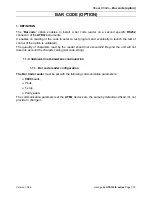
DXZ948RMP
23
English
22
DXZ948RMP
English
No.
Parametric Equalizer Parameters
(car type)
Channel
Band 1
Band 2
Band 3
F
G
Q
F
G
Q
F
G
Q
1
Front
250 Hz
-8 dB
3
2 kHz
-4 dB
1
5 kHz
-4 dB
1
(SEDAN-1)
Rear
250 Hz -10 dB
3
1.25 kHz
0 dB
5
8 kHz
0 dB
5
2
Front
250 Hz -10 dB
7
800 Hz
-4 dB
3
8 kHz
-5 dB
1
(SEDAN-2)
Rear
80 Hz
3 dB
7
125 Hz
-12 dB
5 1.25 kHz
0 dB
5
3
Front
250 Hz
-8 dB
3
1 kHz
-8 dB
3
10 kHz
-6 dB
1
(WAGON-1)
Rear
250 Hz
-8 dB
3
800 Hz
-8 dB
1
8 kHz
0 dB
5
4
Front
250 Hz
-8 dB
7
400 Hz
-10 dB
7 1.25 kHz
-8 dB
7
(WAGON-2)
Rear
125 Hz
-8 dB
3
500 Hz
-5 dB
5
1.6 kHz
0 dB
3
5
Front
125 Hz
-4 dB
5
1.25 kHz
-4 dB
3
2 kHz
3 dB
7
(MINI VAN-1)
Rear
250 Hz
-6 dB
1
630 Hz
-4 dB
3
8 kHz
0 dB
5
6
Front
250 Hz
-4 dB
3
1.25 Hz
-8 dB
3
80 Hz
3 dB
3
(MINI VAN-2)
Rear
250 Hz
-8 dB
3
500 Hz
-5 dB
5
8 kHz
0 dB
5
AC-Processor III Operations
Radio Operations
Q curve : 20 Q curve : 1
Q curve : (Q)
FREQUENCY (centre frequency selection)
Selects the frequency to be used as the centre
of the frequency band to be compensated from
the range 20Hz to 20kHz.
(1/3 octave steps, 31 points)
GAIN (gain adjustment)
Adjusts the gain (output level) within the range
-12dB to +12dB.
(1dB steps, 25 points)
Q (Q curve selection)
Sets one of 1, 3, 5, 7, or 20 as the sharpness of
the Q curve.
●
Compensation
There is no need to compensate frequency
characteristics if they are flat (no peaks or
valleys) when you have measured the
frequency characteristics with a measuring
device. However, sometimes the frequency
characteristics rise or fall in some places. If this
happens, the frequency characteristics must be
compensated. Create a frequency curve having
characteristics that are opposite to the centre
frequency of parts where the characteristics rise
and fall to cancel out these peaks and values,
and make the frequency characteristics as flat
as possible.
Making the frequency characteristics as flat as
possible is called “compensation.”
On this unit, frequency characteristics can be
compensated by P.EQ (Parametric Equalizer).
●
Compensation of frequency
characteristics
The figure below shows the relationship
between the centre frequency, gain and Q
curve.
3dB
Q =
F
f
f
●
Q curve
The Q curve becomes sharper when the
numerical value is increased, and smoother
when the numerical value is decreased.
Flat frequency characteristics can be made by
selecting a Q curve opposite to that of the curve
to be compensated.
F: Centre frequency, G: Gain (output level), Q: Q curve
Screen displays in the radio
mode
■
Main display
This is displayed by pressing the [ROTARY]
knob and selecting the radio mode.
FM1
BAND
MANU
B
MODE
3
4
2
98.10MHz
PS NAME
Touching the left of the display for 1 second or
longer switches the simple operation display.
BAND
B
MODE
98.10MHz
SIMPLE MODE
Frequency display
The frequency currently being received is
displayed.
Touching
or the
in the standard
operation display allows you to perform seek
tuning or manual tuning.
Title display
Displays the name of the broadcast channel
currently being received. Touching this name
switches the display.
Reception band display
AM:
AM band name
FM1:
FM band name
Preset No. display
Touching
in the standard operation
display selects a preset memory.
MODE
Touching this displays sub-functions. Touching
and holding this for 1 second or longer displays
the preset memory list.
P-SCAN:
This is displayed during a preset scan.
Touching this ends the preset scan.
A-STORE:
This is displayed during an auto store.
Touching this ends auto store.
BAND
Touching this switches the reception band.
Touching and holding this for 1 second or longer
switches between the manual tuning mode and
the seek tuning mode.
a
d
(only in the simple operation display)
Touching these enables seek tuning or step
tuning (in the manual tuning mode).
Touching and holding these enables quick
tuning (in the manual tuning mode).
■
Preset memory list display
This is displayed when MODE is touched and
held for 1 second or longer in the main display.
RTN
104. 1MHz
87. 5MHz
004
001
107. 9MHz
87. 9MHz
005
002
108. 0MHz
98. 1MHz
006
003
TITLE LIST
:
Tuning in progress
RTN:
Touch this to return to the main display.
Listening to the radio
1. Press the [ROTARY] knob to select the radio
mode.
Each press of the [ROTARY] knob switches
the mode as follows:
Radio
➜
(DAB)
➜
CD / MP3
➜
(CD
Changer)
➜
(DVD Changer)
➜
(TV)
➜
AUX
➜
Radio...
∗
The mode of equipment that is not
connected is not displayed.
2. Touch BAND to switch the reception band.
Each touch of BAND switches the reception
band as follows:
FM1
➜
FM2
➜
FM3
➜
AM (MW / LW)
➜
FM1...
Manual
indicator
Preset No.
display
Title display
Frequency
display
Title display
Frequency display
Reception band
Station name (or frequency)
Preset No.
Level
(dB)
Gain
(G)
Center Frequency (F)
Frequency
(Hz)
Q curve (Q)
Frequency
curve













































